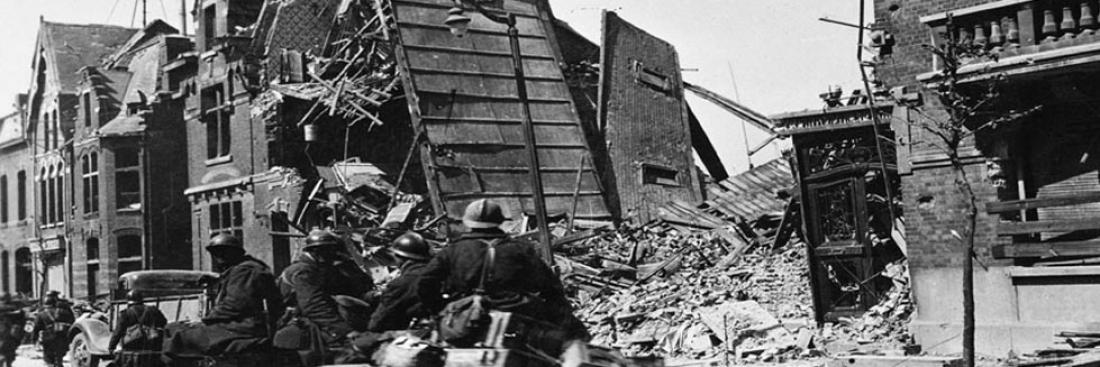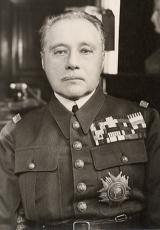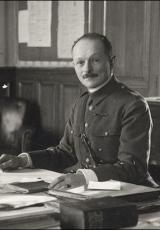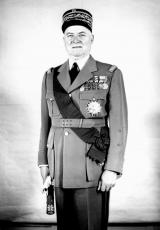La bataille de la Dyle - mai 1940

Corps 1
At 10 am on the 10th May 1940, preceded by vehicles from their reconnaissance groups and the cavalry engineering corps, the 7th and 1st French armies and the British expeditionary corps broke through into Belgium. Using the Dyle manoeuvre, planned since November 1939, they came to support units of the 7th army on the Anvers-Namur line against the German offensive, advancing as far as Holland.
Corps 2
A powerful force, composed of 14 French divisions and 9 British divisions, supported by Belgian divisions, was thus engaged along a front between the sea and the Sambre-Meuse river.
These troops, under the command of General Billotte, head of the No. 1 group of armies, were answerable to Generals Georges (North-Eastern front) and Doumenc (G.Q.G.), whilst supreme command of the ground forces was at General Gamelin's HQ, at Vincennes. The enemy invaded Holland, Belgium and Luxembourg with its 72 division strong A and B groups of armies, that is five armies, supported by a powerful air force. In Belgium, the French army would face a cavalry corps, two armoured divisions and several tank battalions of nine armoured divisions (PzD. or Panzer-Divisions), split into four armoured corps (PzK.). This German force consisted of around 2,500 tanks. By the evening of the 10th May, the 2nd and 3rd D.L.M. (the abbreviations are explained at the bottom of the page) of General Prioux's cavalry corps had pushed deep into Belgium to hold a covering position along the Tirlemont-Huy line, in order to cover the arrival of the 1st army. On the 11th May, Generals Georges and Billotte ordered the acceleration of the Dyle manoeuvre, as the Belgian army was already proving to be outflanked.
French tanks thus reached the Albert canal, near Liège. On the two days that followed, General Prioux's C.C. took most of the impact because it was in the path of the advance of General Hoeppner's 16th PzK, whose 3rd and 4th panzerdivisionen attacked with force. He had to retreat until he reached General Blanchard's first army, who had set up a defensive position between the Dyle and the Meuse, aligning his 3rd, 4th and 5th army corps in the Gembloux-Wavre gap at Namur.
On the 12th and 13th May, the Belgian army was in full retreat towards Anvers and Malines, whilst fighting broke out along the Gette, inside the French covering position. Supported by dive-bombers, German tanks attacked, clashing at Crehen with the 3rd squadron of the 2nd cuirassiers. The battle pitched tanks against each other, with the enemy having superiority in numbers. Following three hours of intense fighting, Lieutenant Geneste's platoon of five tanks was destroyed. The 3rd squadron lost 11 of its 20 tanks and Captain Sainte-Marie-Perrin was killed. Sub-lieutenant Lotsisky's platoon also heroically succumbed. Counter-attacks using Somua S35 and Hotchkiss H39 tanks went well, despite the enemy's anti-tank defence and at Marilles, a surrounded section of the 11th dragoons was released. Tanks clashed at Crehen, Merdorp, Thisnes, Jandrain and Jauche. The 2nd (General Bougrain) and 3rd D.L.M. (General Langlois) clung on steadfastly, with some units selflessly sacrificing their lives. The enemy was contained for a time, but pushed the defenders into a retreat; they lost a lot of tanks under shelling from tank operators and French artillery, but the latter suffered from a lack of air support, despite the fact that 18 Bréguet 693 aircraft from the I and II/54 groups had bombed the roads out of Tongres the previous day, losing 9 machines, brought down by the German D.C.A., or Flak. The would-be victors of 1944-45, Colonels Vernejoul, de Touzier and du Vigier, who would become tank Generals in de Lattre's army, fought in the 3rd D.L.M.
On the 14th, enemy pressure increased as they took Saint-Trond and Perwez and reached Gembloux, despite the unremitting French defence. Towards midday, 35 panzers reached Ernage, running headlong into Moroccan units of the African army, who pushed them back. The artillery of the cavalry corps (75, 105 short, 47 and 25 canons) was to be involved in the fighting until the following day.
To the south, at Huy-sur-Meuse, the town was held tenaciously by the 54th and 56th battalions of motorised machine gunners, along with sections of the 4th light mechanised brigade, covering the general retreat of Prioux's C.C.. The first German attack against the 1st army was curbed. On the evening of the 14th, this army had taken up position from Wavre to Namur, between the British and the Belgians: the 2nd North African D.I., the 1st motorised D.I., the 1st Moroccan Division, the 15th motorised D.I., the 12th motorised D.I., the 5th North African D.I., Generals Dame, de Camas, Mellier, Juin, Janssens and Vieillard, the 3rd, 4th and 5th army corps, in other words, 18 infantry regiments, 12 artillery regiments and 6 G.R.D.I were lined up. Amongst the infantrymen were 7 regiments of tirailleurs (four Moroccan, two Algerian and 1 Tunisian) and 3 regiments of Zouaves (the 8th, 11th and 14th). At the centre of the disposition, the 4th C.A. comprising the 1st D.M. and the 15th D.I.M. was commanded by General Aymes. The head of the 15th division, Juin, would be the victor in the Battle of Garigliano in 1944. The C.C., which had withdrawn, had had a very effective operation, as had the reconnaissance groups that had helped them. The cavalry had suffered losses of 50 to 60% of personnel and two thirds of their Hotchkiss tanks and a third of their Somuas had been destroyed.
They had inflicted losses on the attacking forces of around 160 damaged or destroyed tanks. On the 15th May, the German attack was widespread along the French front. The centre of the position, at Ernage, was a particular target for the 3rd and 4th PzD. Bombing, by artillery shells and stuka bombs, prepared the ground for the attack from tanks and foot soldiers. The position was a large, mostly flat plain, with scattered towns and farms, intersected by a few streams and a railway line. The 22nd Algerians and 11th Zouaves of the 2nd D.I.N.A. put up resistance at Ottignies and Limelette. The 110th R.I. of the1st D.I.M. were almost overwhelmed, despite their valiant fighting. The enemy was advancing between them and the 7th Moroccans. Via the bois de l'Hermitage, it reached the artillerymen of the 15th R.A.D. who were forced to defend their canons. Under machine gun fire, General de Camas' P.C. was forced to withdraw. The Germans were stopped by fierce defensive action. On the Moroccan Division's side, the 80th G.R.D.I. fought hard, as did the R.T.M. who resisted for all they were worth against the masses of tanks and infantry, but the village of Ernage was taken by the enemy.
The 2nd battalion of the 7th R.T.M. counter attacked. Amongst its soldiers was General Mellier, who travelled on motorbike to give orders in the middle of the fighting. From Ernage, German tanks attacked in waves, supported by their air force which fired upon French positions on the ground. The battle raged at Gembloux, Courtil-Noirmont, Beuzet and Chastre. Towards 3 pm the 2nd R.T.M., accompanied by tanks, stopped the enemy advance in its sector, with a cost of 35% losses. The 1st Moroccan also held out. Although Stuka dive bombers bombarded the batteries of the 64th and 264th R.A.A., African artillerymen fired directly on German tanks, destroying them and leaving them to burn. Their shells and the anti-tank missiles of the infantrymen's 25 canons decimated the tanks. And so, forty carcasses of destroyed tanks lay along the 2nd R.T.M.'s front. Gunners of the 1st and 201st R.A. and the 15th D.I.M., crushed enemy attacks, supporting the operations of the 134th R.I. near Gembloux and those of the 4th and 15th R.I. Blocked and hard-hit, the assailants failed to make any headway. Their army changed course, mostly toward the south east. On the French side, losses were heavy, ranging from 30 to 50% of the units' strength.
The infantry divisions fought without any hope of withdrawal, only retreating on orders from above. On the evening of the 15th May they remained in control of the ground from which the enemy had withdrawn. From their crucial position, units of Moroccan tirailleurs quelled six major German assaults. But as the 9th Army had been breached at Dinant-sur-Meuse by the 39th Panzer-Korps, the risk of becoming surrounded from the south east forced the right flank of the 1st Army to abandon the ground it had so fiercely defended.
On the 16th May the victors at Gembloux withdrew behind the Brussels-Charleroi canal. The previous day, enemy tanks had advanced on Philippeville, repelling the 2nd and 11th army corps. At Mettet and Flavion, reinforcements came from General Bruneau's 1st Reserve Armoured Division and confronted the 5th and 7th PzD in furious tank battles. On the 18th May the battle of Flanders began, as enemy panzers pushed on to the west between Maubeuge and Rethel. The battles of the Escaut were about to begin. In 1947 and 48, the 1st and 2nd R.T.M. and the 64th R.A.A. were cited on the order of the army and rewarded for their heroic actions of May 1940. Each ribbon on their flags received the Croix de Guerre with a palm and on the silk of their emblems this glorious inscription is embroidered in gold letters: GEMBLOUX 1940. They were also decorated with the Belgian Croix de Guerre with palm.
Places of Remembrance
As soon as the fighting ended, enemy burial teams proceeded to bury the bodies of servicemen still lying on the theatre of operations. After the war, the maintenance of several small French military cemeteries in Belgium by the Graves Department of the Ministry of Ex-servicemen in Paris proved to be difficult. Despite the return of bodies to their families, thanks to the act of the 16th October 1946, relating to some 2,000 graves, in Belgium there still remained over 1,000 graves to be united. In 1950, consideration was given to accommodating them in a single necropolis.
The French ambassador advised the Belgian government of this intention. In 1967, the latter made the necessary land available to France for the creation of a cemetery, 7 km from Gembloux.
Work began immediately to develop the 700 square metre site, located in the town of Chastre, in the Brabant area and lasted from 1968 to 1971. In June and July 1969 the French services exhumed 1,058 bodies, of which 65 were returned to their families. The exhumation of mortal remains was carried out in 311 Belgian communes, some of which were far to the south in the province of Luxembourg. These regrouping operations involved those who had fallen in the fighting of 1940 throughout Belgium and not just at Gembloux. The French military cemetery in Chastre was to take in those who had died in the 1940 Battle of Belgium and whose families wanted them to rest with their brothers in arms. Those who died for France from the 4th army corps only account for 21% of the total and the North Africans who rest there represent 30% of those buried, of which the majority are Moroccans.
The necropolis was inaugurated on the 10th May 1970 by Mr. Duvillard, the Minister for Ex-servicemen and the Victims of War and Mr. Segers, the Minister for the National Defence of the Kingdom of Belgium, in the presence of the Moroccan Ambassador, Generals Mellier, Touzet and Vigier, the Burgomaster of Chastre, several ex-servicemen and the Walloon people. The French cemetery took in a total of 192 French bodies from the 1914 to1918 war, of whom 3 are unknown and 1,030 French from the 1939 to1945 war, of whom 171 are unknown. From the period around 1940, those buried belong to several infantry regiments, as well as to units of Moroccan tirailleurs and to many other different units, reflecting the extent of French intervention in Belgium. At Jandrain, in the Brabant region, a monument was erected to the cavalry corps, a landmark of the glorious epic tale of the tank crews of the 10th May 1940, adorned with crest and helmet and the proud motto "First and last into the fire", surmounted by the goddess representing France, a female warrior brandishing a shield, a symbol evoking the armour on the tanks. This memorial was inaugurated on the 17th May 1953 by the French and Belgian authorities in the presence of General Langlois, the former head of the 3rd D.L.M., and former soldiers of Prioux's C.C. Other more modest monuments, steles and plaques, erected by associations or families can also be found in Belgium to commemorate the operations, the French units and the soldiers there in May 1940.
Abbreviations B.C.C.: Bataillon de Char de Combat (Battalion of Combat Tanks) C.A.: Corps d'Armée (Army Corps) C.C.: Cavalry Corps D.C.A.: Défense Contre Avions (Anti-Aircraft Defence) D.I.M.: Division d'Infanterie Motorisée (Motorised Infantry Division) D.L.M.: Division Légère Mécanique (Light Mechanical Division) D.M.: Division Marocaine (Moroccan Division) G.R.: Groupe de Reconnaissance (Reconnaissance Group) G.Q.G.: Grand Quartier General (General Headquarters) R.A.A.: Régiment d'Artillerie d'Afrique (African Artillery Regiment) R.A.D.: Régiment d'Artillerie Divisionnaire (Divisional Artillery Regiment) R.C.C.: Régiment de Chars de Combat (Regiment of Combat Tanks) R.T.M.: Régiment de Tirailleurs Marocains (Regiment of Moroccan Tirailleurs)




